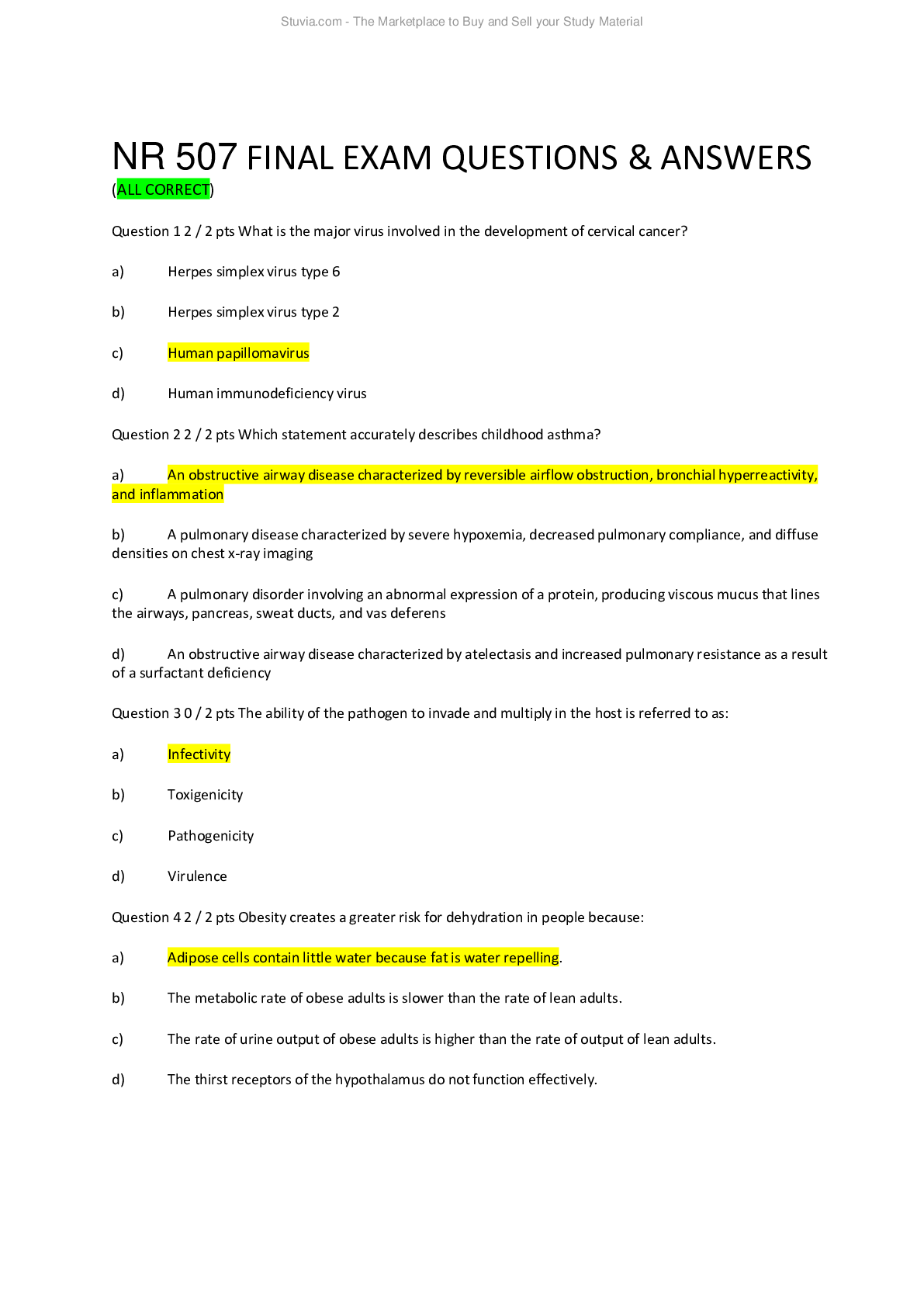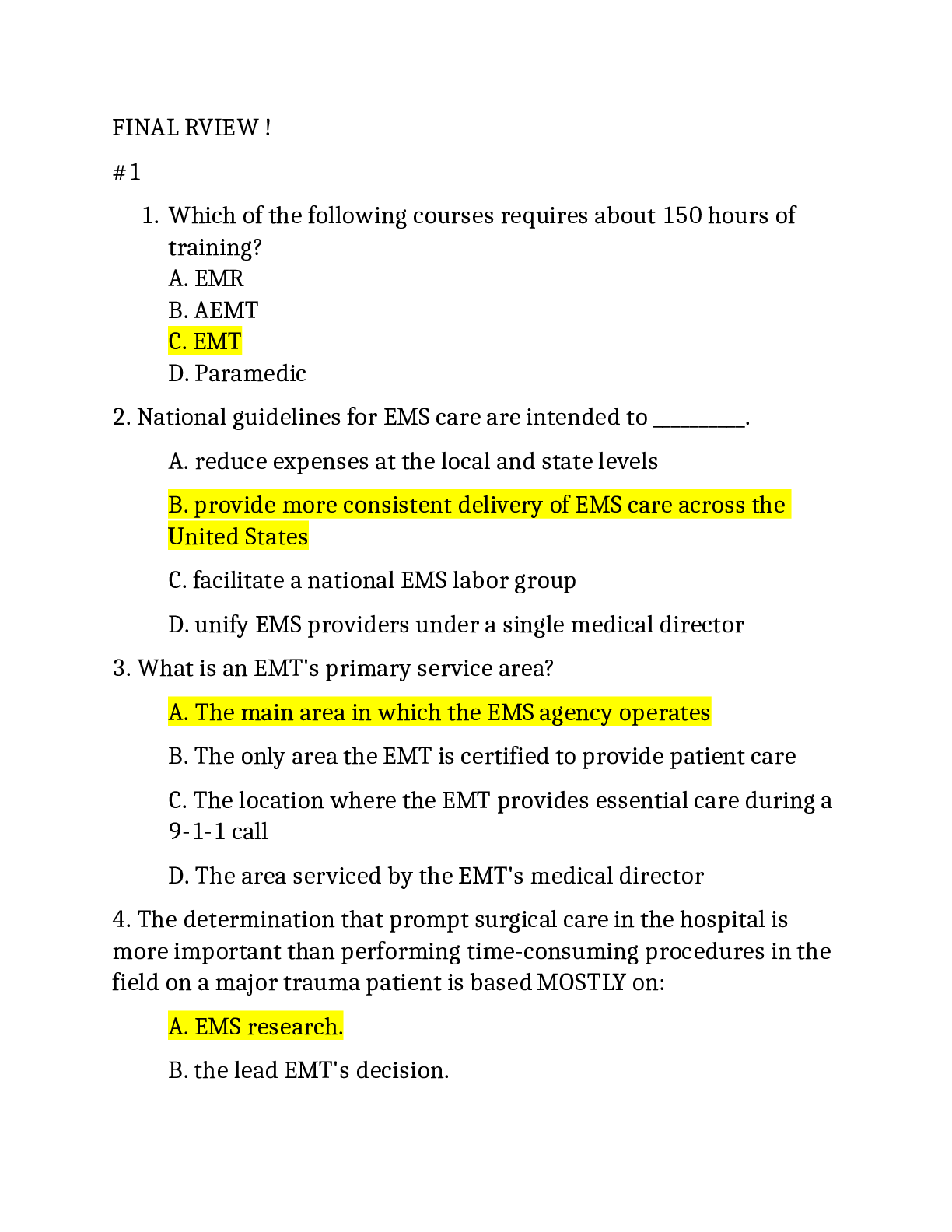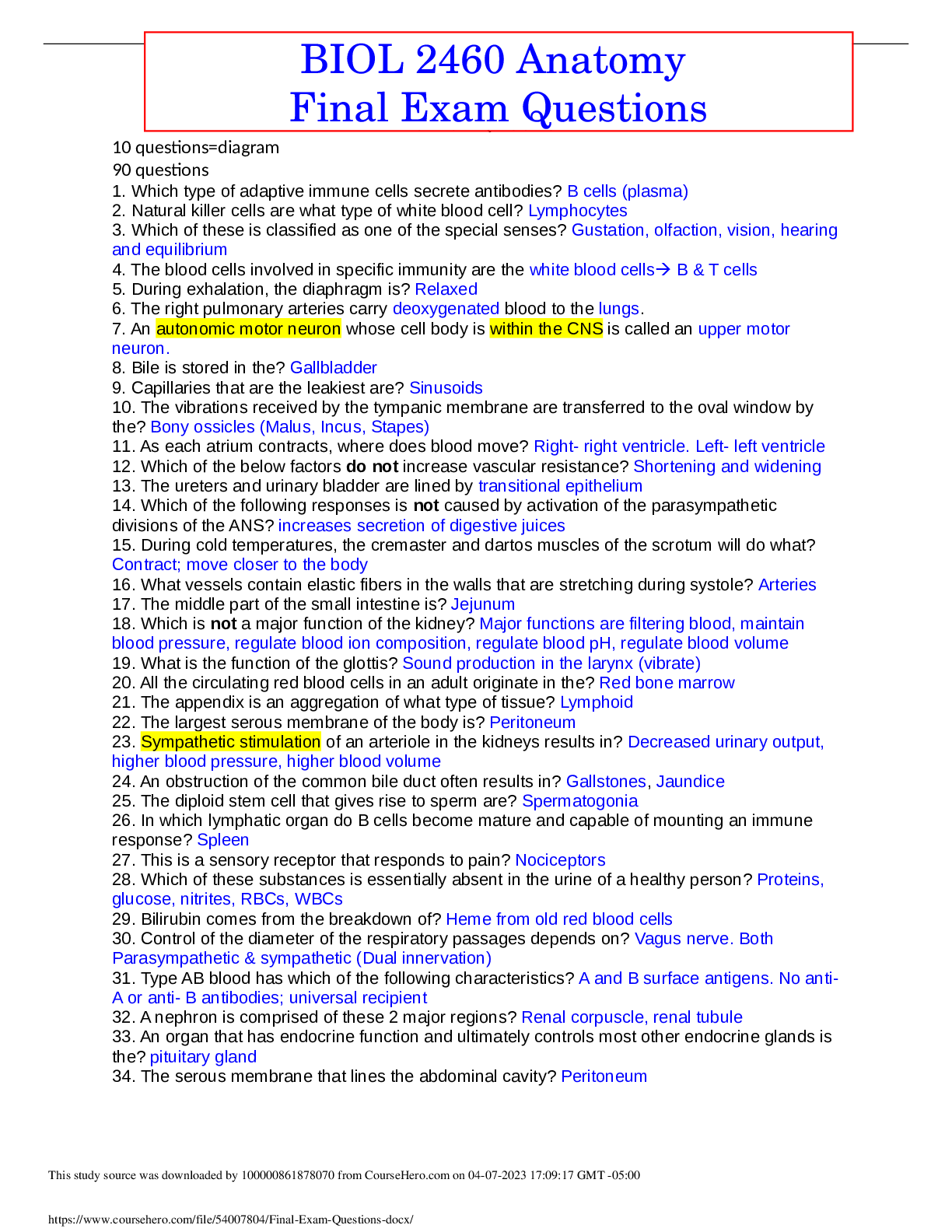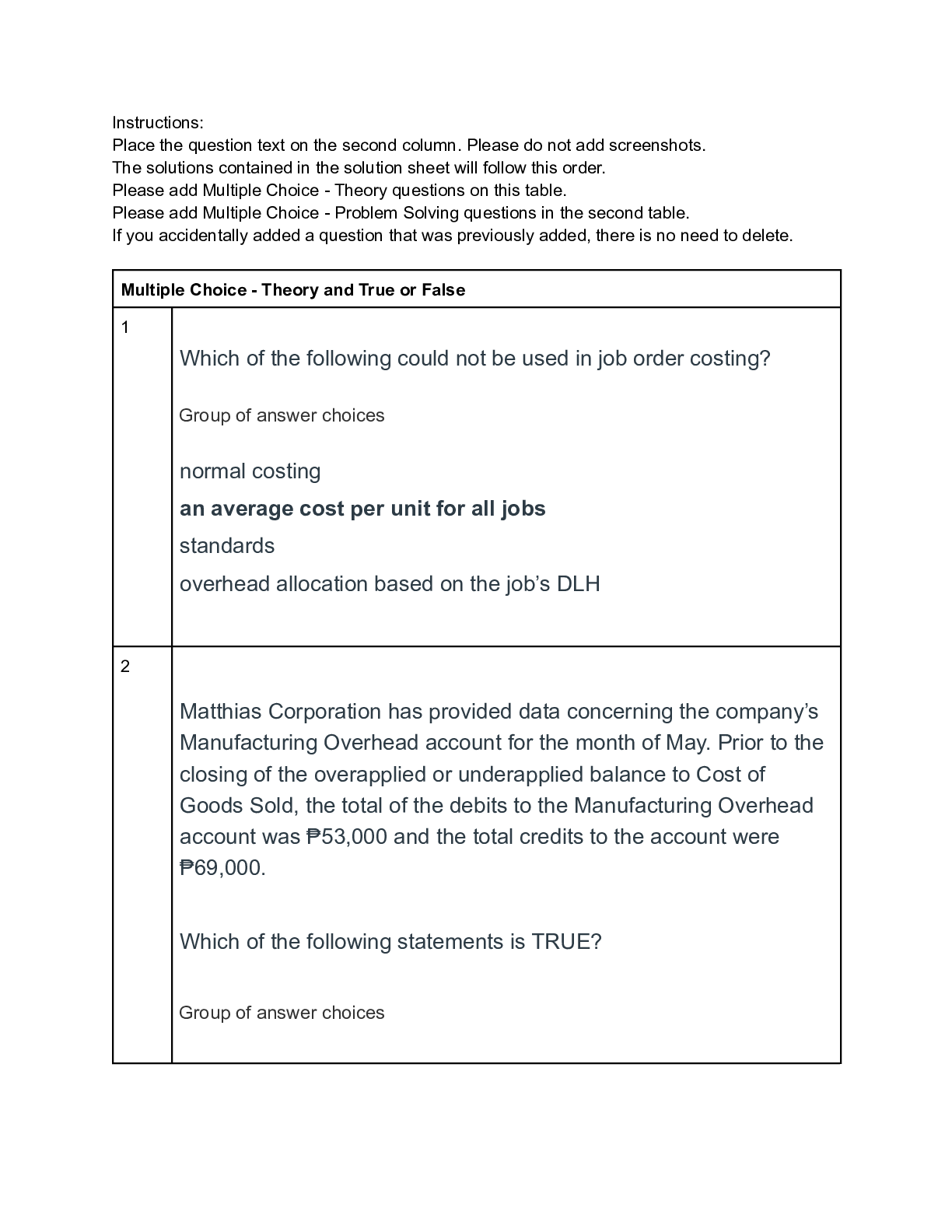*NURSING > Final Exam Review > PN2 NUR257 (NUR2571) / PN 2 Exam 1 questions & Answers |PN2 NUR2571 Exam 1|Latest Spring 2021/2022 C (All)
PN2 NUR257 (NUR2571) / PN 2 Exam 1 questions & Answers |PN2 NUR2571 Exam 1|Latest Spring 2021/2022 Complete Solutions
Document Content and Description Below
PN 2 Exam 1 questions & Answers. 1. A client has a tracheostomy tube in place. When the nurse suctions the client, food particles are noted. What action by the nurse is best? 2. A nurse assesses a cli... ent after an open lung biopsy. Which assessment finding is matched with the correct intervention? 3. A nurse assesses a clients respiratory status. Which information is of highest priority for the nurse to obtain? 2. A nurse assesses a client who is experiencing an acid-base imbalance. The clients arterial blood gas values are pH 7.34, PaO2 88 mm Hg, PaCO2 38 mm Hg, and HCO3 19 mEq/L. Which assessment should the nurse perform first? 6. A nurse assesses a client who is admitted with an acid-base imbalance. The clients arterial blood gas values are pH 7.32, PaO2 85 mm Hg, PaCO2 34 mm Hg, and HCO3 16 mEq/L. What action should the nurse take next? 7. A nurse is assessing a client who is recovering from a lung biopsy. Which assessment finding requires immediate action? 8. A nurse is caring for a client who has just experienced a 90-second tonic-clonic seizure. The clients arterial blood gas values are pH 6.88, PaO2 50 mm Hg, PaCO2 60 mm Hg, and HCO3 22 mEq/L. Which action should the nurse take first? 8. A nurse is caring for a client who is scheduled to undergo a thoracentesis. Which intervention should the nurse complete prior to the procedure? 9. A nurse assesses a client after a thoracentesis. Which assessment finding warrants immediate action? 1.A nurse is caring for a client who has just had a central venous access line inserted. Which action should the nurse take next? 3.A nurse teaches a client who is being discharged home with a peripherally inserted central catheter (PICC). Which statement should the nurse include in this clients teaching? 5.A nurse is caring for a client who is receiving an epidural infusion for pain management. Which assessment finding requires immediate intervention from the nurse? 7.A nurse is assessing clients who have intravenous therapy prescribed. Which assessment finding for a client with a peripherally inserted central catheter (PICC) requires immediate attention? 13.A nurse teaches a client who is prescribed a central vascular access device. Which statement should the nurse include in this clients teaching? 14.A nurse is caring for a client with a peripheral vascular access device who is experiencing pain, redness, and swelling at the site. After removing the device, which action should the nurse take to relieve pain? 17.A nurse prepares to flush a peripherally inserted central catheter (PICC) line with 50 units of heparin. The pharmacy supplies a multi-dose vial of heparin with a concentration of 100 units/mL. Which of the syringes shown below should the nurse use to draw up and administer the heparin? 2.A nurse assesses a client who has a peripherally inserted central catheter (PICC). For which complications should the nurse assess? (Select all that apply.) 11. While assessing a client who has facial trauma, the nurse auscultates stridor. The client is anxious and restless. Which action should the nurse take first? 8.A nurse assesses a clients peripheral IV site, and notices edema and tenderness above the site. Which action should the nurse take next? 3. A nurse assesses a client who has facial trauma. Which assessment findings require immediate intervention? (Select all that apply.) 12. A nurse is caring for a client who is experiencing excessive diarrhea. The clients arterial blood gas values are pH 7.28, PaO2 98 mm Hg, PaCO2 45 mm Hg, and HCO3 16 mEq/L. Which provider order should the nurse expect to receive? 5. A nurse assesses clients on the medical-surgical unit. Which client is at greatest risk for development of obstructive sleep apnea? 7. A nurse cares for a client who is experiencing epistaxis. Which action should the nurse take first? 2.A client is prescribed 250 mL of normal saline to infuse over 4 hours via gravity. The facility supplies gravity tubing with a drip factor of 15 drops/mL. At what rate (drops/min) should the nurse set the infusion to 1.A client is prescribed 1000 mL of normal saline to infuse over 24 hours. At what rate should the nurse set the pump (mL/hr) to deliver this infusion? (Record your answer using a whole number.) ____ mL/hr 12. A nurse is caring for a client who has sleep apnea and is prescribed modafinil (Provigil). The client asks, How will this medication help me? How should the nurse respond? 2. A nurse assesses a client who has developed epistaxis. Which conditions in the clients history should the nurse identify as potential contributors to this problem? (Select all that apply.) 3. After teaching a client who is prescribed a long-acting beta2 agonist medication, a nurse assesses the clients understanding. Which statement indicates the client comprehends the teaching? 9. A nurse is teaching a client who has cystic fibrosis (CF). Which statement should the nurse include in this clients teaching? 10. While assessing a client who is 12 hours postoperative after a thoracotomy for lung cancer, a nurse notices that the lower chest tube is dislodged. Which action should the nurse take first? 13. A nurse cares for a client who had a chest tube placed 6 hours ago and refuses to take deep breaths because of the pain. Which action should the nurse take? 14. A nurse cares for a client who has a chest tube. When would this client be at highest risk for developing a pneumothorax? 17. The nurse is caring for a client who is prescribed a long-acting beta2 agonist. The client states, The medication is too expensive to use every day. I only use my inhaler when I have an attack. How should the nurse respond? 5. A nurse assesses a client who has a chest tube. For which manifestations should the nurse immediately intervene? (Select all that apply.) 8. A nurse is caring for a client using oxygen while in the hospital. What assessment finding indicates that goals for a priority diagnosis are being met? 10. A nurse cares for a client who had a bronchoscopy 2 hours ago. The client asks for a drink of water. Which action should the nurse take next? 8.A client has been diagnosed with tuberculosis (TB). What action by the nurse takes highest priority? 12.A nurse has educated a client on isoniazid (INH). What statement by the client indicates teaching has been effective? 3. A client has a tracheostomy that is 3 days old. Upon assessment, the nurse notes the clients face is puffy and the eyelids are swollen. What action by the nurse takes priority? 15.A client has been hospitalized with tuberculosis (TB). The clients spouse is fearful of entering the room where the client is in isolation and refuses to visit. What action by the nurse is best? 16.A client is being discharged on long-term therapy for tuberculosis (TB). What referral by the nurse is most appropriate? 1. A nurse assesses a client who has appendicitis. Which clinical manifestation should the nurse expect to find? 2. A nurse cares for an older adult client who has Salmonella food poisoning. The clients vital signs are heart rate: 102 beats/min, blood pressure: 98/55 mm Hg, respiratory rate: 22 breaths/min, and oxygen saturation: 92%. Which action should the nurse complete first? 5. A nurse assesses a client who is hospitalized with an exacerbation of Crohns disease. Which clinical manifestation should the nurse expect to find? 9. After teaching a client who is prescribed adalimumab (Humira) for severe ulcerative colitis, the nurse assesses the clients understanding. Which statement made by the client indicates a need for additional teaching? 8. A nurse cares for a client with chronic obstructive pulmonary disease (COPD). The client states that he no longer enjoys going out with his friends. How should the nurse respond? 11. A nurse assesses a client who has ulcerative colitis and severe diarrhea. Which assessment should the nurse complete first? 16. A nurse cares for a client with chronic obstructive pulmonary disease (COPD) who appears thin and disheveled. Which question should the nurse ask first? 22. A nurse cares for a client with ulcerative colitis. The client states,” I feel like I am tied to the toilet.” This disease is controlling my life. How should the nurse respond? 10. A nurse cares for a client who is prescribed mesalamine (Asacol) for ulcerative colitis. The client states, I am having trouble swallowing this pill. Which action should the nurse take? 7. A nurse assesses a client with ulcerative colitis. Which complications are paired correctly with their physiologic processes? (Select all that apply.) 1. The student nurse studying stomach disorders learns that the risk factors for acute gastritis include which of the following? (Select all that apply.) 13. A client is recovering from an esophagogastroduodenoscopy (EGD) and requests something to drink. What action by the nurse is best? 19. A nurse teaches a client who is at risk for colon cancer. Which dietary recommendation should the nurse teach this client? 1. A nurse assesses a client who is admitted for treatment of fluid overload. Which manifestations should the nurse expect to find? (Select all that apply.) 15.A nurse assesses a client who was started on intraperitoneal therapy 5 days ago. The client reports abdominal pain and feeling warm. For which complication of this therapy should the nurse assess this client? 4. A nurse has conducted a community screening event for oral cancer. What client is the highest priority for referral to a dentist? 6. A client is having a temporary tracheostomy placed during surgery for oral cancer. What action by the nurse is best to relieve anxiety? 9. A client had an oral tumor removed this morning and now has a tracheostomy. What action by the nurse is the priority? 2. A nurse studying cancer knows that job-related risks for developing oral cancer include which occupations? (Select all that apply.) 8.A client is in the emergency department with an esophageal trauma. The nurse palpates subcutaneous emphysema in the mediastinal area and up into the lower part of the clients neck. What action by the nurse takes priority? 6.A nurse is teaching clients with gastroesophageal reflux disease (GERD) about foods to avoid. Which foods should the nurse include in the teaching? (Select all that apply.) 12. A nurse is assessing clients on a medical-surgical unit. Which client is at risk for hypokalemia? 15. A client at risk for developing hyperkalemia states, I love fruit and usually eat it every day, but now I cant because of my high potassium level. How should the nurse respond? 11. A nurse cares for a client who has a serum potassium of 7.5 mEq/L and is exhibiting cardiovascular changes. Which prescription should the nurse implement first? 14. After teaching a client to increase dietary potassium intake, a nurse assesses the clients understanding. Which dietary meal selection indicates the client correctly understands the teaching? 4. A nurse is assessing a client who has an electrolyte imbalance related to renal failure. For which potential complications of this electrolyte imbalance should the nurse assess? (Select all that apply.) 1. A nurse assesses a client with diabetes mellitus who is admitted with an acid-base imbalance. The clients arterial blood gas values are pH 7.36, PaO2 98 mm Hg, PaCO2 33 mm Hg, and HCO3 18 mEq/L. Which manifestation should the nurse identify as an example of the clients compensation mechanism? 13. A nurse is assessing a client with hypokalemia, and notes that the clients handgrip strength has diminished since the previous assessment 1 hour ago. Which action should the nurse take first? 6. After administering 40 mEq of potassium chloride, a nurse evaluates the clients response. Which manifestations indicate that treatment is improving the clients hypokalemia? (Select all that apply.) 7. A nurse develops a plan of care for a client who has a history of hypocalcemia. What interventions should the nurse include in this clients care plan? (Select all that apply.) 3. A nurse assesses a client who is prescribed furosemide (Lasix) for hypertension. For which acid-base imbalance should the nurse assess to prevent complications of this therapy? 4. A nurse is caring for a client who is experiencing moderate metabolic alkalosis. Which action should the nurse take? 9. A client presents to the emergency department reporting severe abdominal pain. On assessment, the nurse finds a bulging, pulsating mass in the abdomen. What action by the nurse is the priority? 10. A nurse assesses a clients oral cavity and observes the condition depicted in the photo below: What action by the nurse is best? 14. A nurse assesses a client with a mechanical bowel obstruction who reports intermittent abdominal pain. An hour later the client reports constant abdominal pain. Which action should the nurse take next? 1. A nurse inserts a nasogastric (NG) tube for an adult client who has a bowel obstruction. Which actions does the nurse perform correctly? (Select all that apply.) 5. A nurse cares for a client who has been diagnosed with a small bowel obstruction. Which assessment findings should the nurse correlate with this diagnosis? (Select all that apply.) 4. A nurse assesses a client who is prescribed a medication that inhibits angiotensin I from converting into angiotensin II (angiotensin-converting enzyme [ACE] inhibitor). For which expected therapeutic effect should the nurse assess? 7. After teaching a client who is prescribed a restricted sodium diet, a nurse assesses the clients understanding. Which food choice for lunch indicates the client correctly understood the teaching? 10. A nurse is caring for a client who has the following laboratory results: potassium 3.4 mEq/L, magnesium 1.8 mEq/L, calcium 8.5 mEq/L, sodium 144 mEq/L. Which assessment should the nurse complete first? 10. A nurse evaluates the following arterial blood gas values in a client: pH 7.48, PaO2 98 mm Hg, PaCO2 28 mm Hg, and HCO3 22 mEq/L. Which client condition should the nurse correlate with these results? 11. After providing discharge teaching, a nurse assesses the clients understanding regarding increased risk for metabolic alkalosis. Which statement indicates the client needs additional teaching? 13. A nurse is caring for a client who received benzocaine spray prior to a recent bronchoscopy. The client presents with continuous cyanosis even with oxygen therapy. Which action should the nurse take next? 13. The nurse assesses the client using the device pictured below to deliver 50% O2: The nurse finds the mask fits snugly, the skin under the mask and straps is intact, and the flow rate of the oxygen is 3 L/min. What action by the nurse is best? 3. A nurse assesses a client who reports waking up feeling very tired, even after 8 hours of good sleep. Which action should the nurse take first? 1. A nurse assesses several clients who have a history of asthma. Which client should the nurse assess first? 28. A nurse evaluates the following arterial blood gas and vital sign results for a client with chronic obstructive pulmonary disease (COPD): Which action should the nurse take first? 5.The charge nurse on a medical unit is preparing to admit several clients who have possible pandemic flu during a preparedness drill. What action by the nurse is best? 13.A client has been taking isoniazid (INH) for tuberculosis for 3 weeks. What laboratory results need to be reported to the health care provider immediately? 18.A client has the diagnosis of valley fever accompanied by myalgias and arthralgias. What treatment should the nurse educate the client on? 7. A nurse is caring for four clients. After receiving the hand-off report, which client should the nurse see first? 4.A client with an esophageal tumor has difficulty swallowing and has been working with a speech-language pathologist. What assessment finding by the nurse indicates that the priority goal for this problem is being met? 13.A nurse works on the surgical unit. After receiving the hand-off report, which client should the nurse see first? 11. A nurse cares for a client who states, My husband is repulsed by my colostomy and refuses to be intimate with me. How should the nurse respond? 16. A nurse cares for a client who had a colostomy placed in the ascending colon 2 weeks ago. The client states, The stool in my pouch is still liquid. How should the nurse respond? 20.A client is admitted with suspected pneumonia from the emergency department. The client went to the primary care provider a few days ago and shows the nurse the results of what the client calls an allergy test, as shown below: What action by the nurse takes priority? 3.A client in the emergency department is taking rifampin (Rifadin) for tuberculosis. The client reports yellowing of the sclera and skin and bleeding after minor trauma. What laboratory results correlate to this condition? (Select all that apply.) 18.A home care nurse prepares to administer intravenous medication to a client. The nurse assesses the site and reviews the clients chart prior to administering the medication: Based on the information provided, which action should the nurse take? 4. A nurse is planning discharge teaching on tracheostomy care for an older client. What factors does the nurse need to assess before teaching this particular client? (Select all that apply.) 1.The nurse is aware that which factors are related to the development of gastroesophageal reflux disease (GERD)? (Select all that apply.) 21.A nurse admits a client from the emergency department. Client data are listed below: History/70 years of age/ History of diabetes/ On insulin twice a day/ Reports new-onset dyspnea and productive cough/ What action by the nurse is the priority? 3. A client with peptic ulcer disease is in the emergency department and reports the pain has gotten much worse over the last several days. The clients blood pressure when lying down was 122/80 mm Hg and when standing was 98/52 mm Hg. What action by the nurse is most appropriate? 12. A nurse assesses a client with Crohns disease and colonic strictures. Which clinical manifestation should alert the nurse to urgently contact the health care provider? 13. A nurse reviews the chart of a client who has Crohns disease and a draining fistula. Which documentation should alert the nurse to urgently contact the provider for additional prescriptions? 19. A nurse plans care for a client with Crohns disease who has a heavily draining fistula. Which intervention should the nurse indicate as the priority action in this clients plan of care? [Show More]
Last updated: 1 year ago
Preview 1 out of 1 pages

Reviews( 0 )
Document information
Connected school, study & course
About the document
Uploaded On
Apr 24, 2021
Number of pages
1
Written in
Additional information
This document has been written for:
Uploaded
Apr 24, 2021
Downloads
0
Views
46



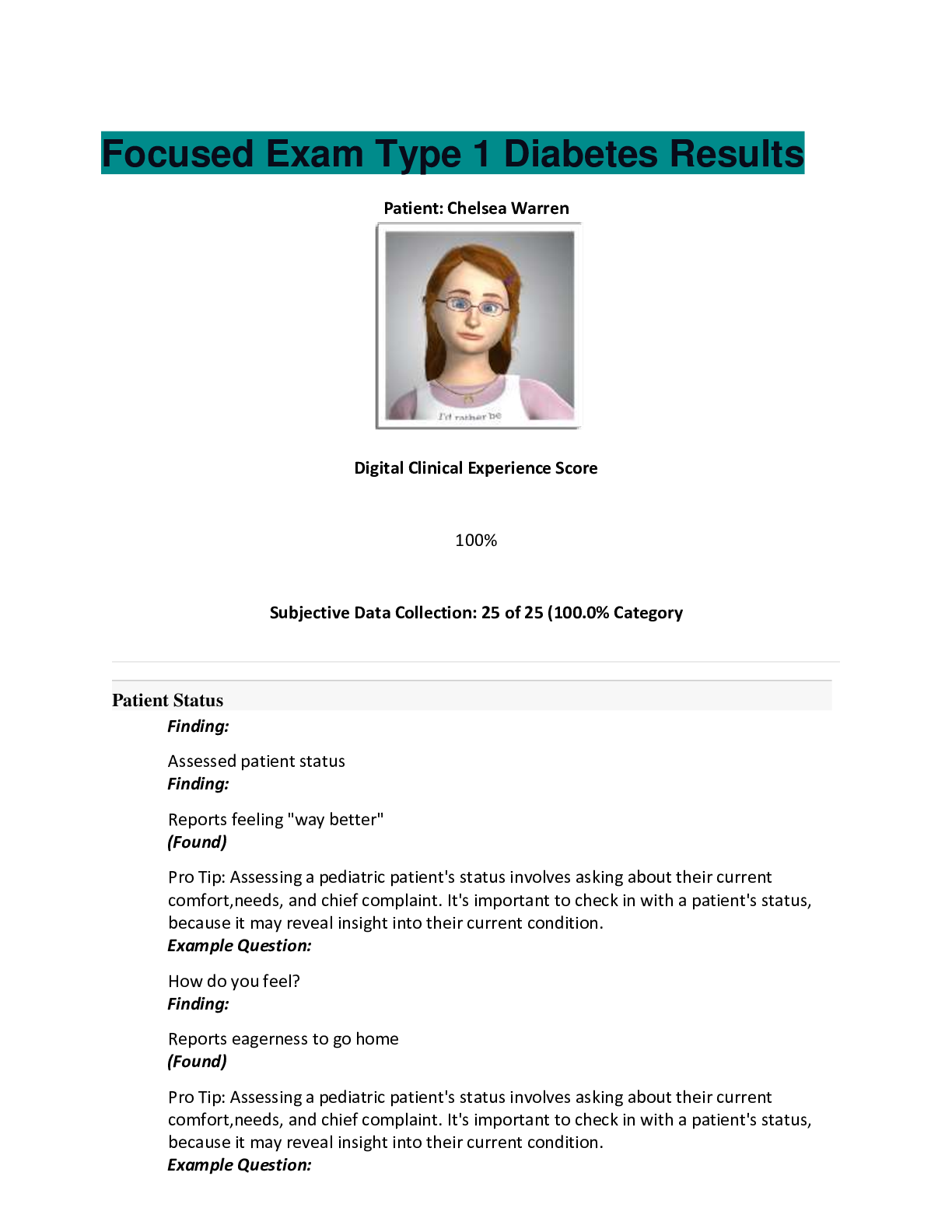
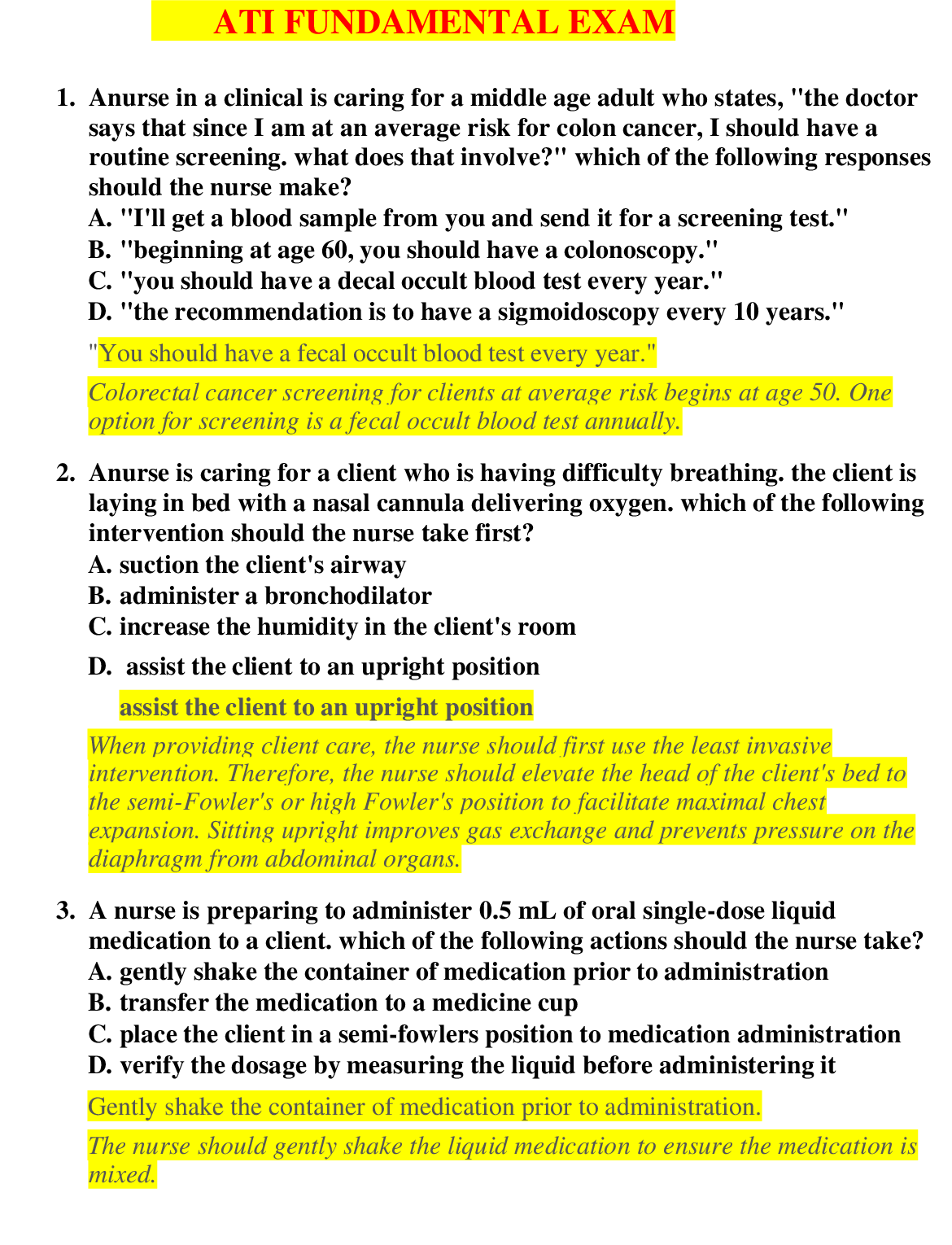



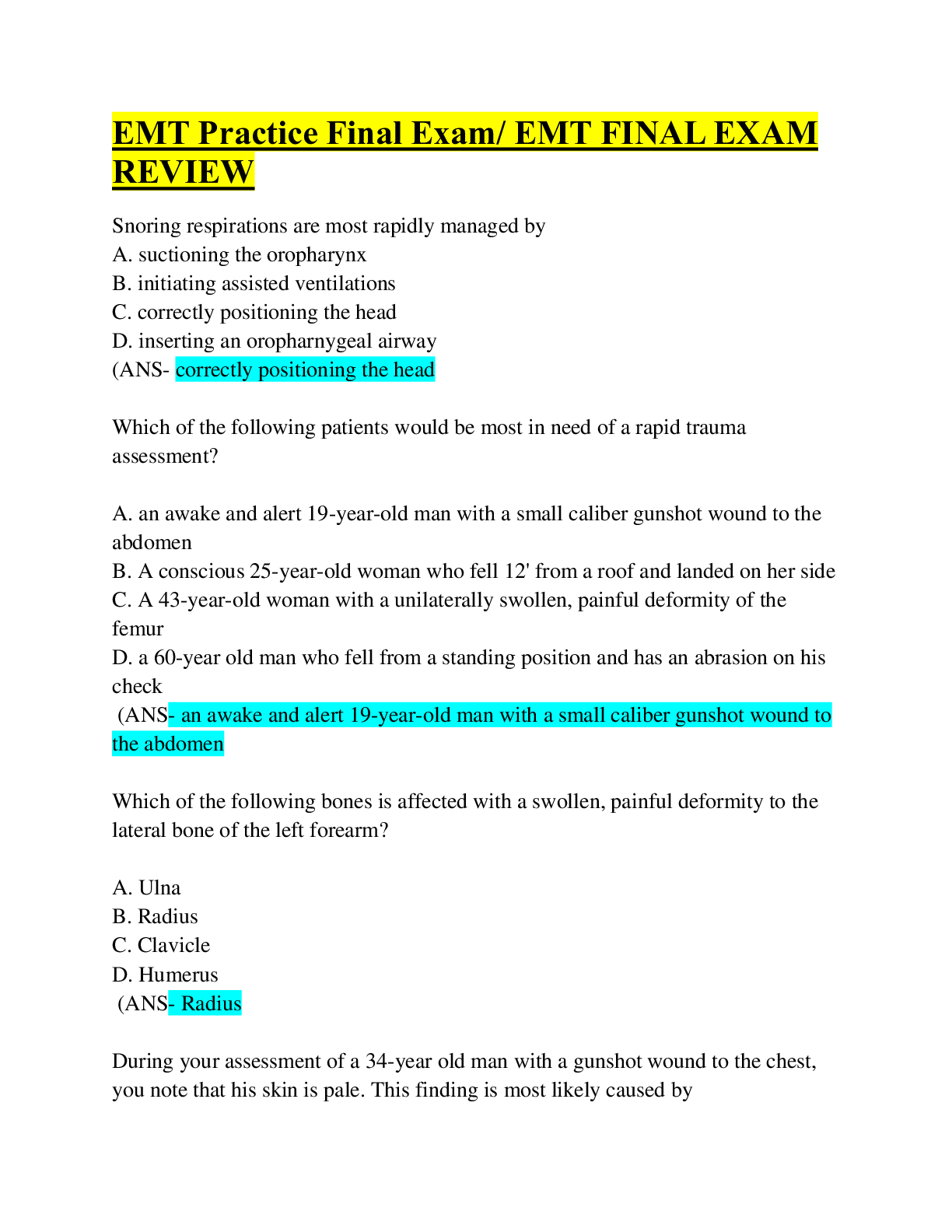
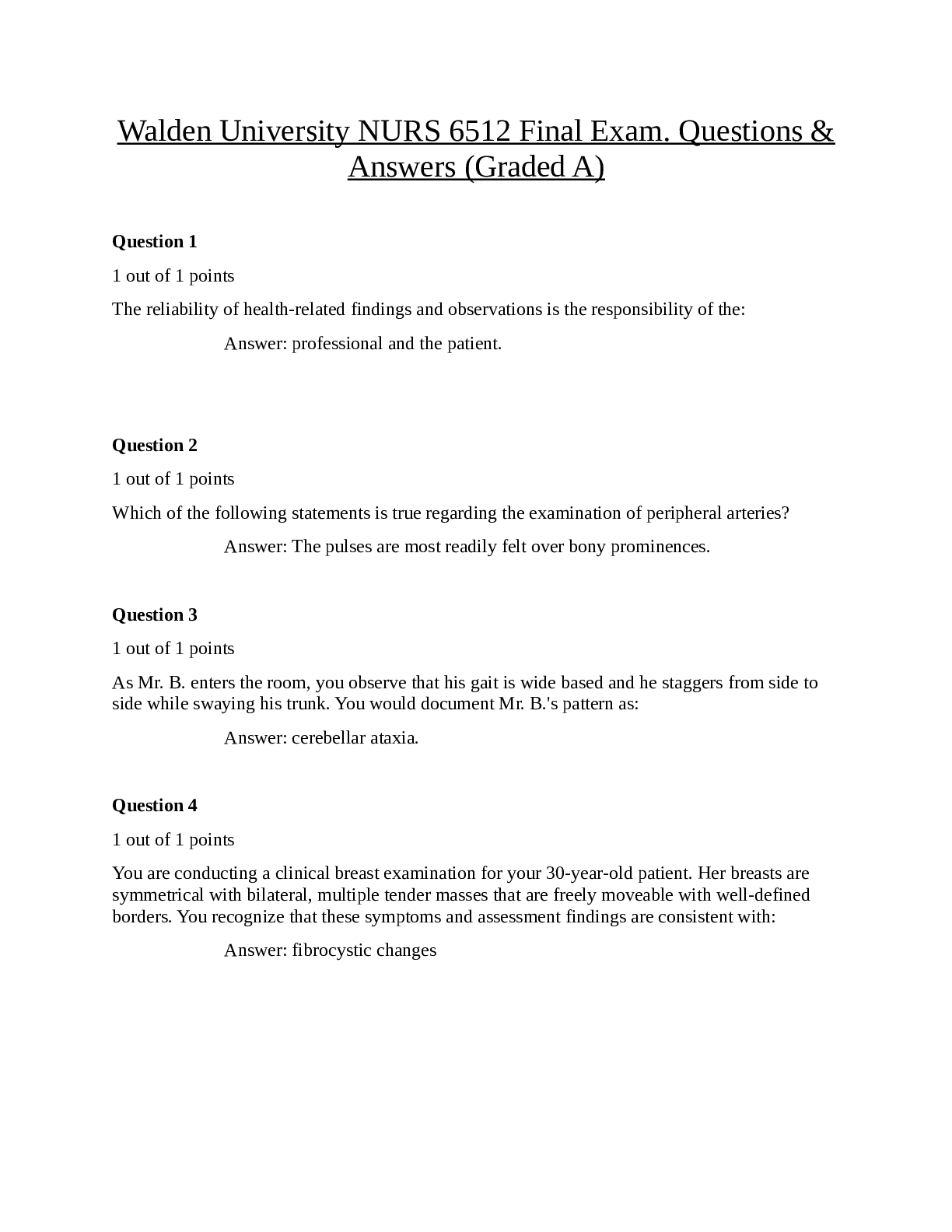
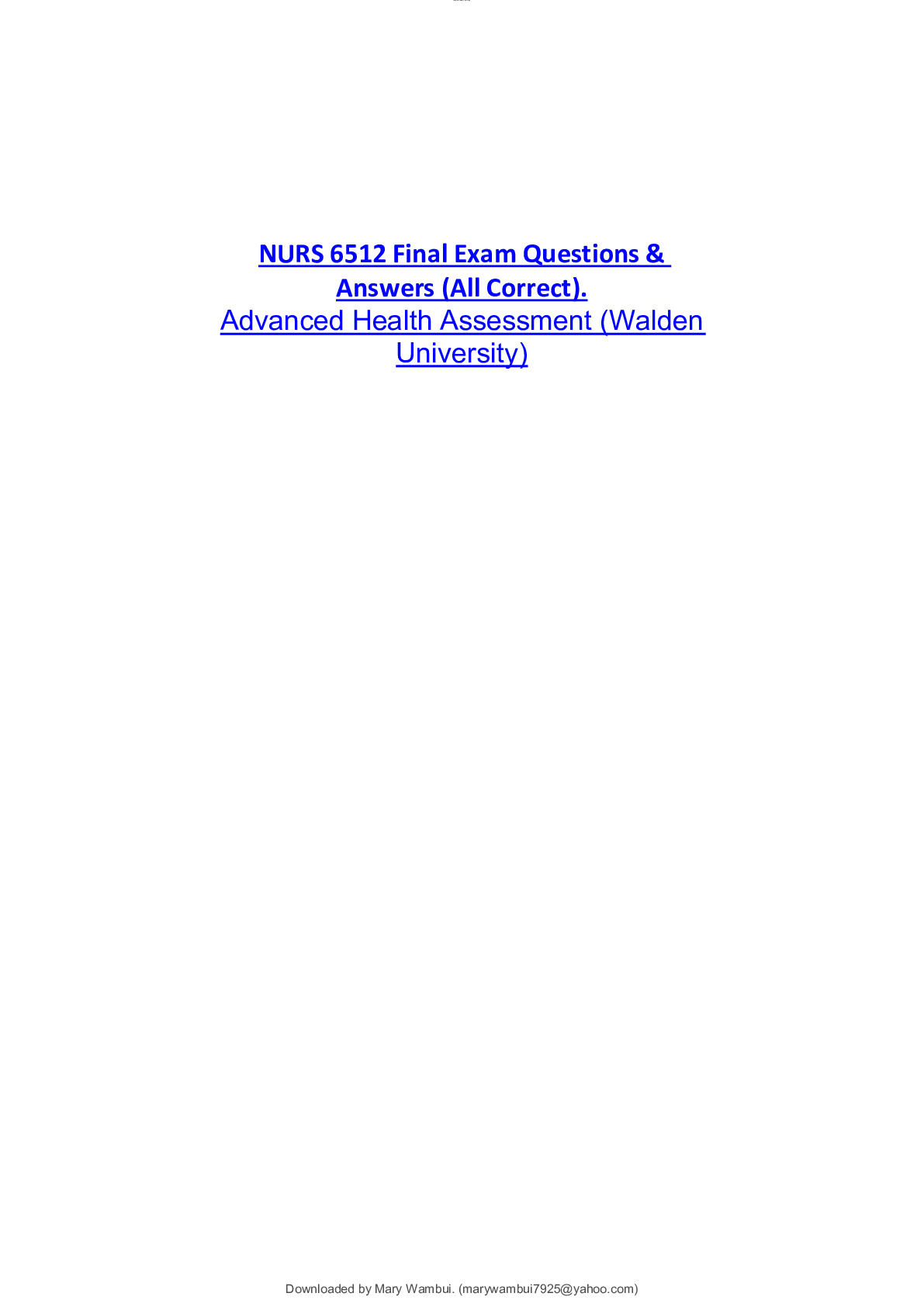
.png)
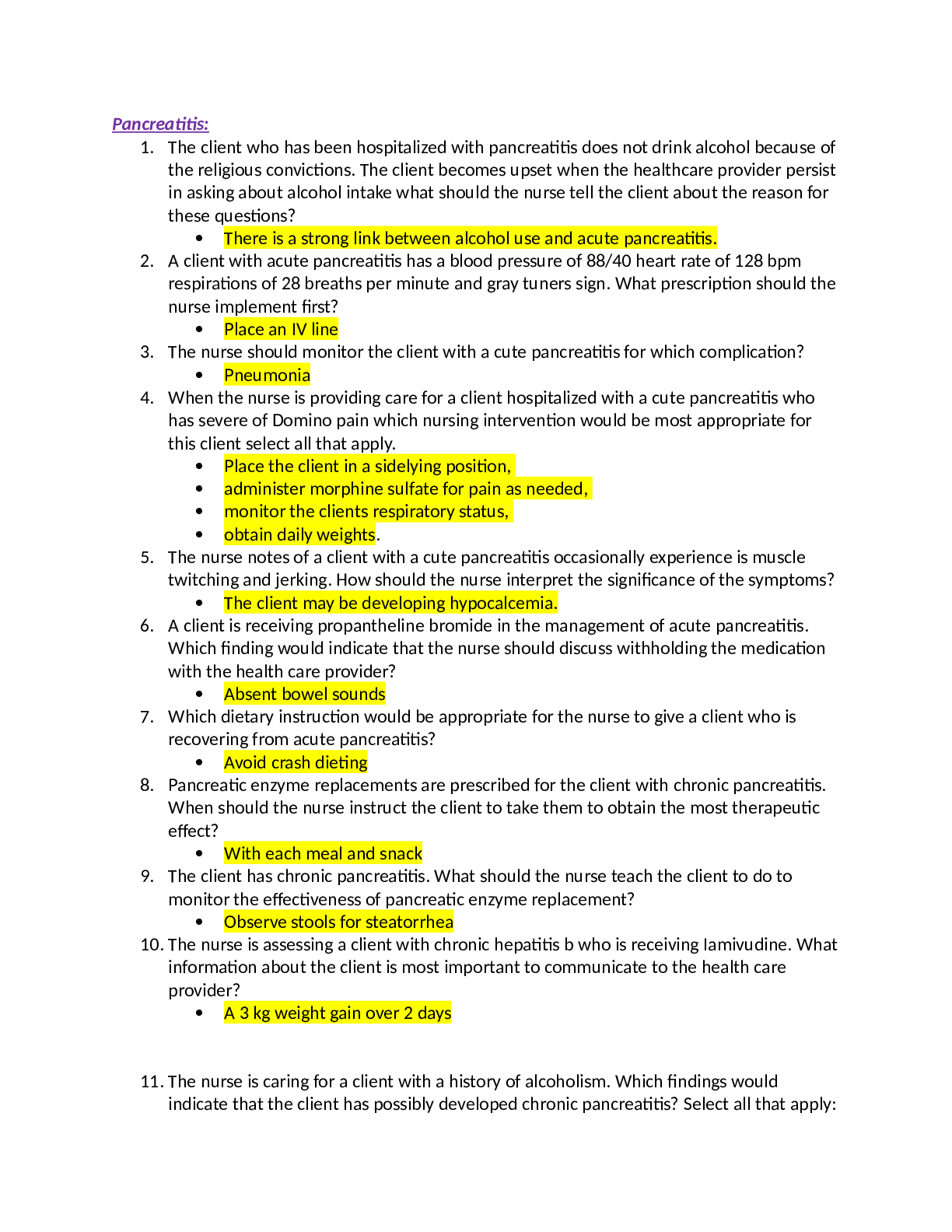


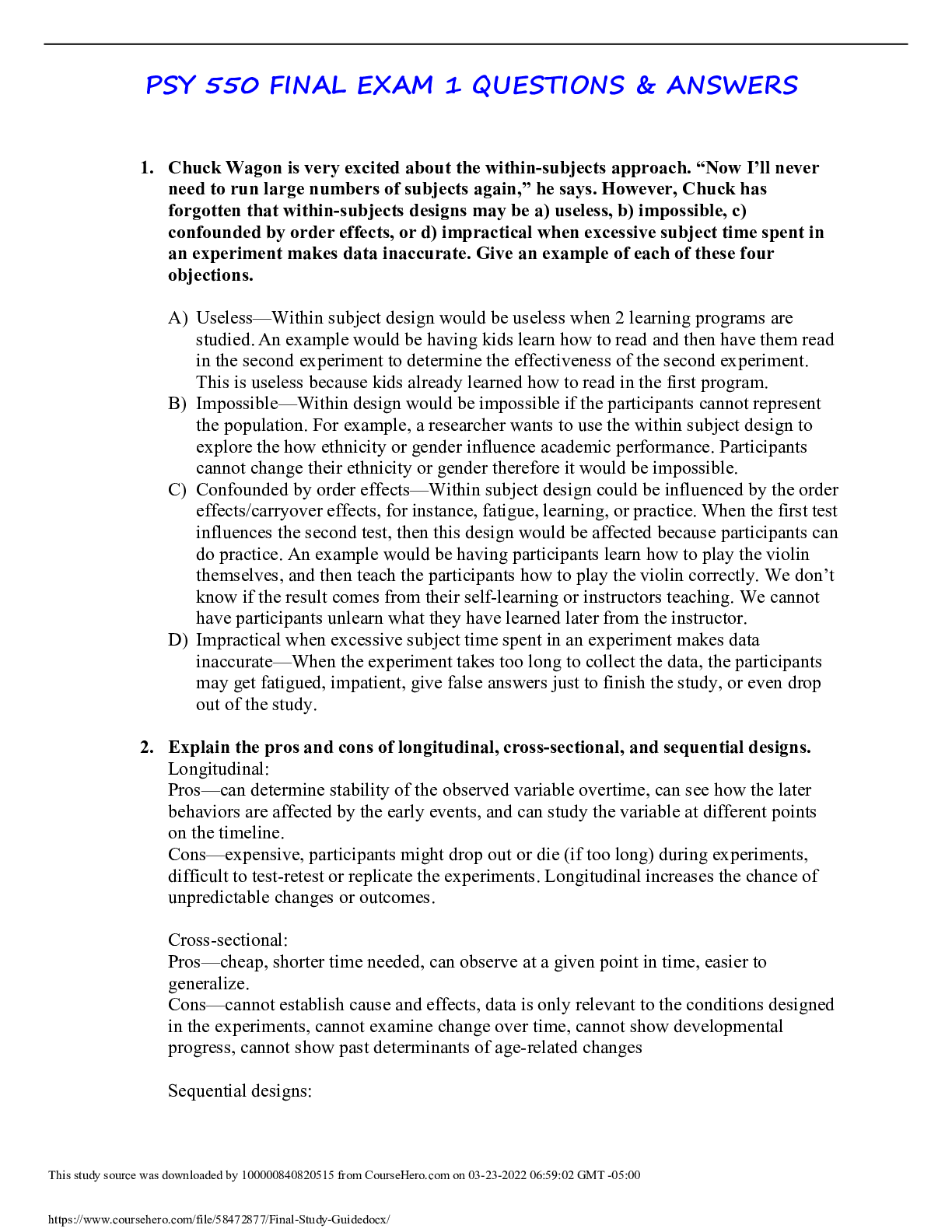

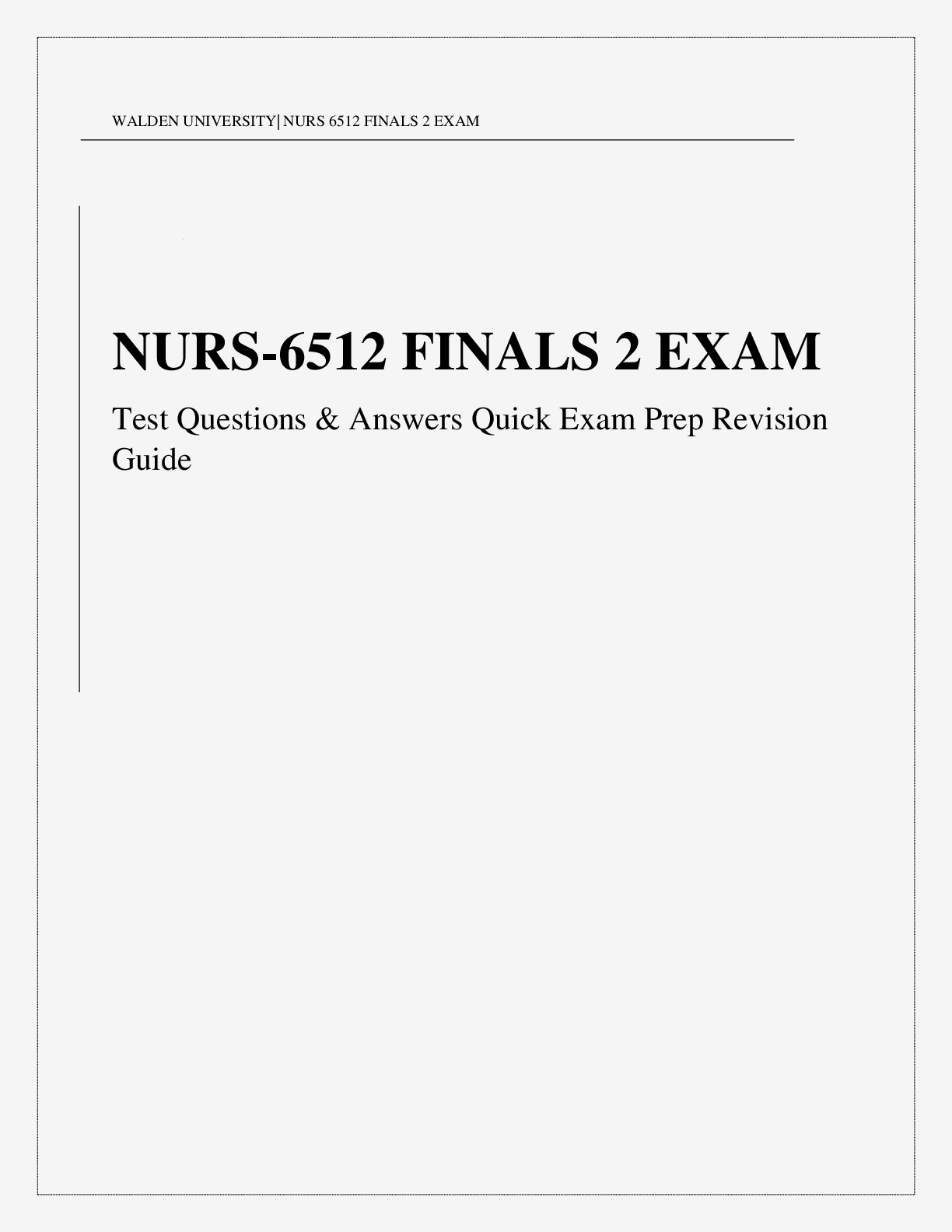
.png)

